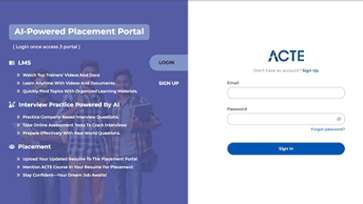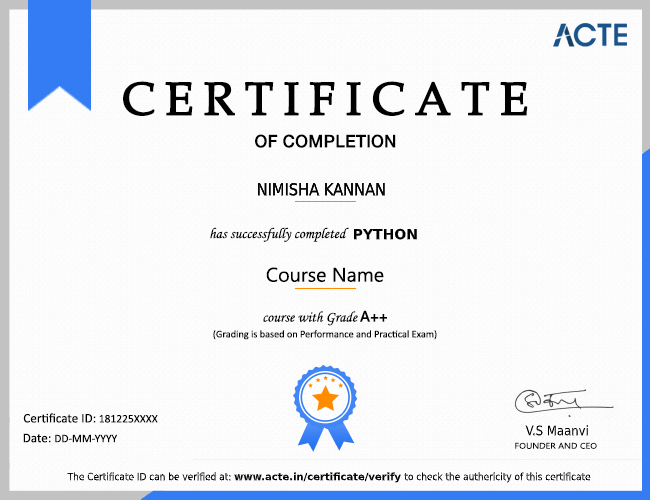ACTE offers Continuous Testing In DevOps Online Training is provided to assist you in learning Continuous Testing In DevOps from the ground up. Experts built this Continuous Testing In DevOps Course to provide you hands-on experience with a variety of Continuous Testing In DevOps concepts like object-oriented programming and other modules for third parties. The career of Continuous Testing In DevOps programming is increased with this Continuous Testing In DevOps certification. Continuous Testing in DevOps Online Training provides a variety of library support, including basic comprehension information for many languages. The high needs of leading sectors in countries such as France, the United Kingdom, and the United States and also all over the world have attracted a lot of attention.
Additional Info
What is Continuous testing in DevOps?
Continuous DevOps testing is a form of software testing which involves the testing of software at every stage of the software life cycle. Continuous testing aims to assess the quality of software at each stage of the Continuous Delivery Process by testing early and often. DevOps, an agile software development methodology extension, emphasizes communication, cooperation, and integration among many stakeholders in the software development process, such as development, quality assurance, and operations
Successful Continuous Delivery Approach in Continuous Testing :
Continuous Integration and Continuous Delivery are the two most important aspects of DevOps. Continuous Integration is an important part of agile development since it ensures that software is generated and tested frequently and that issue patches are released quickly. It necessitates members of a team integrating their work daily. After that, an automatic build verifies each check-in, allowing for early defect identification. Continuous Delivery is a strategy that extends agile approach beyond development in a DevOps cycle, taking Continuous Integration to the next level. In today's agile world, continuous delivery is extremely critical. Continuous Delivery enables software to be regularly adjusted in response to user feedback, changes in corporate strategy, and market moves. All teams (test, support, and development) interact and work closely in a Continuous Delivery process to automate and streamline the build, test, and release cycles. By releasing frequently, a successful Continuous Delivery approach results in shortened iterations, decreased risks, lower costs, and a faster time to market.
Career Path of Continuous testing in DevOps :
The DevOps evangelist :
As of now there are IT organizations that have grown to leverage DevOps principles and capabilities, and there are IT organizations that are in the process of doing so. That transformation will not happen on its own, and the individual who will own and deliver that shift will play a critical role. Your leader is a DevOps evangelist.
Importance of Continuous Testing in DevOps :
Well-informed customers nowadays want a consistent user experience. Processes, systems, and infrastructure all require a high level of connectivity and dependability for applications to work. Testing a variety of sophisticated applications, goods, and services can be difficult because testing must ensure that high-quality software is provided quickly. Because DevOps encourages a high level of communication among diverse teams along the development value chain, it can sometimes blur the lines between different responsibilities. It necessitates that everyone contributes as and when needed across the value chain. As a result, a developer may set up deployments, while QA engineers can set up automation test cases and deployment engineers can contribute test cases to the QA repository.
Continuous Testing encompasses the following projects from various software development functions :
Continuous Testing should begin with performance and functionality testing of the code that has been developed by development teams. For testing, they might use open source technologies like Selenium. Functional, performance, UI, API, and other tests, as well as regression tests, are all available to assure a good. To keep the process going, QA testers must guarantee that tests execute in parallel. Every release must pass an acceptance test before being deployed by the Operations team. During the post-production phase, operations managers employ a few monitoring tools to regularly test the application and evaluate its efficiency. A diverse set of tests that can send automated messages can operate 24 hours a day, seven days a week.
How can testers get to a continuous testing state?
We divide web testing into five stages :
-
- Sporadic Organizations test on an as-needed basis. Testing isn't always considered a commercial process, but it might happen on the fly in response to specific input.
- Valued Organizations have realized the importance of testing and have made it a standard procedure for major changes and releases. Testing has begun to include s at this point.
- Adopted Organizations have established a well-defined procedure that includes specialized testing resources. At this point, testers have begun scripting tests or using Selenium-based technologies.
- optimized Automation has become an element of the testing process, and testers are part of a formal testing or QA department. To improve the user experience, there is a clear strategy to use cross-platform and cross-browser testing.
- Strategic Organizations have established a best-in-class testing team that is well-integrated into the culture of the organization. The company's success depends on its testing philosophy and great web experiences.
1. The release manager :
From development to production, release managers are responsible for the management and coordination of the product. Typically, they focus on the technical issues and obstacles that a traditional project manager would avoid. To support continuous delivery, release managers monitor the coordination, integration, and flow of development, testing, and deployment. They're not interested in anything else.
2. The automation architect :
This function is critical because DevOps relies primarily on automated systems. Automation architects, also known as integration specialists, assess, design, and implement continuous deployment strategies while maintaining high availability on production and pre-production systems.
3. The software developer/tester :
This is an important position in DevOps because it mainly relies on automated systems. Automation architects, also known as integration specialists, assess, design, and implement strategies for continuous deployments on production and pre-production systems while maintaining high availability.
4. The experience assurance (XA) professional :
While the quality assurance (QA) function is frequently part of software development, when firms adopt DevOps, a new sort of control is required. QA testers are no longer required; instead, XA experts are needed to ensure that all new features and functions are delivered with the end user in mind. Currently, the assumption for QA positions is to test functionality.
5. The security engineer :
System security is typically an afterthought in traditional waterfall development. It's a nonfunctional need that's often put on at the end of system development, much like quality assurance. Security engineers work side by side with developers in DevOps-oriented organizations, including their ideas much earlier in the process. They incorporate security into the product rather than adding it at the end.
6. The utility technology player :
Because the most prevalent cause of service interruption is likely to be the apps running on those servers, administrators implement strict controls on what is allowed to execute on their prized assets. They necessitate in-depth testing in a staging environment, thorough handover and operations documentation, and rare releases.
Career in Continuous Testing a smart choice?
Software testing has become increasingly significant in recent decades. The software sector is well aware of the dangers it may face. As a result, they've begun to value software testers more. Let's take a closer look at why positions for continuous testers are steadily increasing.
To be more specific, the career path as a Continuous Tester is currently thriving.
A SDLC would not be complete without testers and developers.
The role of the software tester begins much earlier, when the specifications are being checked.
Continuous Tester Positions are highly specific to IT employers.
Continuous Testing Tools :
QuerySurge :
QuerySurge is a smart data testing solution and the first-of-its-kind comprehensive DevOps continuous data testing solution. Robust API with over 60 calls, detailed data intelligence & analytics, simple integration into the DevOps pipeline for continuous testing, and checks massive volumes of data are just a few of the highlights.
Jenkins :
Jenkins is a Continuous Integration tool built in the Java programming language. The GUI interface or console controls can be used to configure this application.
Travis :
Travis is a GitHub-hosted continuous testing platform. It comes in both hosted and on-premises versions. It offers a wide range of languages as well as comprehensive documentation.
Selenium :
Selenium is a free software testing framework. It works with all of the major browsers, including Firefox, Chrome, Internet Explorer, and Safari. Web application testing is automated with Selenium WebDriver.
Challenges of Continuous Testing :
The existing approach is preventing development and quality assurance personnel from making cultural shifts.
In Agile and DevOps contexts, there is a lack of DevOps skills and appropriate testing tools.
Heterogeneous test environments that will never reflect the real world.
Traditional testing methods and a hazily defined test data management system.
Integration difficulties and late defect remedies result from longer code integration cycles.
Resources and test environments that are insufficient and inadequate
DevOps adoption is hampered by complex application architecture and business logic.
What You're Going to Learn :
DevOps Testing : The aim, advantages, principles, and DevOps testing vocabulary
Differences : How does the DevOps test vary from other test types
Strategies : Testing, test management, and analysis of findings of DevOps
Automation : Strategies for test tools selection and test automation implementation
Integration : integration of DevOps in the continuous integration and delivery processes
DevOps Test Position : How DevOps testers match a culture, organization, and role for DevOps.
The Responsibilities of Continuous Testing in DevOps:
Continuous testing is a continuous feedback method that functions as a catalyst across the product delivery pipeline in a DevOps journey. Defects are fixed sooner in the development process thanks to automated feedback at each level. Actionable feedback is essential because it allows you to go on to the next step in the supply chain.
-
Effective Collaboration and Quality :
Collaboration between development, QA, and operations teams is required for effective continuous testing. Many bottlenecks, such as delayed releases and poor user experiences, are caused by the antiquated assumption that developers own development and QA owns testing.
-
Delivery Pipeline :
Unit testing, integration testing, automated end-to-end testing, and regression testing are just a few of the tests that make up Continuous Testing In DevOps Online Course
You can quickly detect and fix errors by running tests at various points across the delivery pipeline. You also improve performance security before your product's delivery is delayed and expenditures are increased.
-
Test Automation for Reliability :
Continuous testing success necessitates automation. It entails writing a test script, primarily in Selenium, that interacts with functional aspects without requiring human participation.
It not only provides greater scalability and dependability than manual testing, but it also allows manual testers to devote more time to high-value tasks like exploratory testing.
-
Leverage Cloud for Scalability :
Continuous testing success necessitates automation. It entails writing a test script, primarily in Selenium, that interacts with functional aspects without requiring human participation.
It not only provides greater scalability and dependability than manual testing, but it also allows manual testers to devote more time to high-value tasks like exploratory testing.
-
Early discovery :
Continuous testing refers to a process of early testing, regularly testing, testing and automation of the testing process in software engineering.
The original method of testing was centered on the handoff. Jenkins, Travis, and Selenium are popular Continuous Testing and Integration tools that are passed from one team to the next.
Continuous Testing In DevOps Online Course provides useful feedback at each level of the delivery process.































